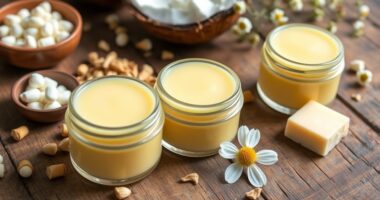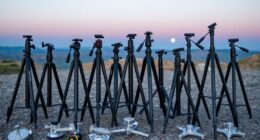Gaiters are protective tubes worn over your lower legs and footwear to keep out dirt, debris, water, and snow during outdoor activities. You should use them when hiking through muddy, snowy, overgrown, or wet terrain to prevent stones and water from entering your shoes. They also help prevent blisters and extend your footwear’s life. If you want to learn more about their types and benefits, keep exploring what gaiters can do for your outdoor adventures.
Key Takeaways
- Gaiters are protective coverings worn over lower legs and footwear to shield against dirt, debris, water, and snow.
- They are ideal for muddy, snowy, overgrown, or wet terrains to prevent damage and discomfort.
- Proper fit with adjustable straps ensures gaiters stay secure and prevent chafing during outdoor activities.
- Made from durable, breathable materials like nylon or GORE-TEX, they extend footwear lifespan and improve comfort.
- Use gaiters when crossing streams, walking through tall grass, or in adverse weather conditions for added protection.

Gaiters are practical accessories designed to protect your lower legs and ankles from dirt, debris, and moisture during outdoor activities. Whether you’re hiking, trekking, or exploring rugged terrain, gaiters serve as an essential piece of footwear protection that keeps your feet dry and clean. As one of the key hiking accessories, they help prevent mud, stones, and water from entering your boots, which can cause discomfort and even blisters. Wearing gaiters can make a significant difference in maintaining foot comfort on long hikes or challenging trails, especially when the weather turns wet or when crossing streams. Their primary function is to create a barrier over your lower legs and footwear, shielding your skin and shoes from the elements and unwanted debris. Properly fitting gaiters also help prevent chafing and allow for a full range of motion, so you stay comfortable during your outdoor adventures.
Choosing the right gaiters depends on the environment you’ll be in. For instance, if you’re heading into snow or muddy conditions, opt for waterproof or insulated gaiters that can withstand moisture and cold. In dry, rocky areas, lighter, breathable gaiters are more suitable because they won’t trap heat or cause excessive sweating. As a critical component of hiking accessories, gaiters complement your footwear protection by adding an extra layer of defense. They also help prevent small stones from working their way into your shoes, which can be incredibly uncomfortable and sometimes lead to injuries. Selecting gaiters made from durable materials like nylon or GORE-TEX can enhance their longevity and performance in tough conditions.
Putting on gaiters is straightforward, but ensuring they fit snugly is key to their effectiveness. They typically come with adjustable straps and hooks that secure them tightly around your footwear and lower legs. When choosing gaiters, consider their material—nylon, polyester, or GORE-TEX are common options that balance durability and breathability. The right gaiters should be lightweight enough for comfort but sturdy enough to withstand rough terrain. Properly fitted gaiters also prevent chafing and allow for a full range of motion, so you stay comfortable during your outdoor adventures.
You should use gaiters whenever the trail gets particularly muddy, snowy, or overgrown. They’re also invaluable if you’re crossing streams or walking through tall grass and bushes. In addition to protecting your footwear, gaiters help keep dirt and debris out of your socks and shoes, reducing the risk of blisters and infections. If you’re serious about outdoor pursuits, investing in a good pair of gaiters is a smart move. They’re versatile, lightweight, and can extend the lifespan of your hiking boots by preventing excessive wear and tear. Overall, gaiters are a simple yet highly effective hiking accessory that enhances footwear protection and keeps you comfortable on any trail.
Frequently Asked Questions
Are Gaiters Suitable for Winter Snow Activities?
Yes, gaiters are great for winter snow activities. They provide essential snowshoeing protection by keeping snow, ice, and moisture out of your boots. As part of your winter hiking gear, gaiters help prevent cold and wet feet, ensuring comfort and dryness during snowshoeing or winter hikes. Wear them over your boots and pants for added insulation and to keep snow from slipping inside, making your winter adventures safer and more enjoyable.
How Do Gaiters Compare to Waterproof Pants?
Did you know gaiters can block over 90% of water? Compared to waterproof pants, gaiters are more versatile, especially since they come in waterproof and breathable types. Waterproof gaiters excel in mud and snow, but breathable options prevent overheating. Gaiter types vary from lightweight to heavy-duty, making them a flexible choice for quick, targeted protection. They’re easier to put on and pack away than full waterproof pants, offering convenience for outdoor adventures.
Can Gaiters Be Used for Cycling or Are They Only for Hiking?
You can definitely use gaiters for cycling and trail running, as they provide excellent cycling protection by shielding your lower legs from mud, dirt, and debris. For trail running, gaiters help keep out rocks and grass, reducing discomfort and potential injuries. They’re versatile gear that enhances your performance and comfort in various outdoor activities, making them a smart addition whether you’re hitting the trail on foot or bike.
What Materials Are Best for Breathable Gaiters?
Breathable fabrics are your best allies when choosing gaiters, like a gentle breeze that keeps you cool on a hot day. Opt for moisture-wicking materials such as nylon, polyester, or Gore-Tex, which actively draw sweat away from your skin. These fabrics help prevent dampness and discomfort, allowing your legs to breathe freely. When your gaiters breathe as easily as you do, you stay comfortable and dry during your outdoor adventures.
Do Gaiters Require Special Care or Maintenance?
You need to regularly clean your gaiters to maintain their durability and performance. Gaiter cleaning involves removing dirt, mud, and sweat, and occasionally washing them according to the manufacturer’s instructions. Proper gaiter storage is essential; keep them in a cool, dry place away from direct sunlight. This prevents mold, odors, and material degradation. Regular maintenance guarantees your gaiters stay in good shape, ready for your next adventure.
Conclusion
Think of gaiters as your trusty shield on a rugged adventure. Just like a knight’s armor protects in battle, gaiters guard your lower legs from mud, stones, and water. When you’re trekking through unpredictable terrain, they keep you moving smoothly, undeterred by nature’s surprises. Wearing gaiters isn’t just about protection—it’s about equipping yourself with the confidence to face any trail head-on. So, gear up wisely, and let your journey unfold fearlessly.








